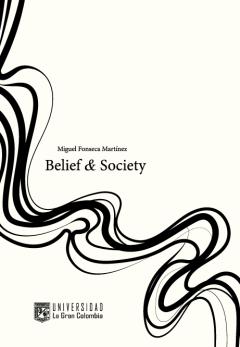Belief & society
Making Ranking Theory Useful for the Social World
Keywords:
Social research, Theory of knowledge, Sociology of knowledge, Social philosophy, Ranking TheorySynopsis
Belief & Society: Making Ranking Theory Useful for the Social is a critical and constructive inquiry on Wolfgang Spohn's Ranking theory and its philosophical applications in social epistemology.
Miguel Fonseca introduces a new way of methodological research in social sciences and a new way to understand the deep ontology of society and human relations. This novel account shows the relevance of ranking theory as a helpful theory of rationality, and it clarifies how it can be applied to the social wordl. Therefore, the book highlights certain foundational and methodological aspects of social sciencis and their importance.
Chapters
Downloads
References
Alchourron, C., Gärdenfors, P., & Makinson, D. (1985). On the Logic of Theory Change. Journal of Symbolic Logic, 50(2), 510–530. https://doi.org/10.2307/2274239
Aristotle. (2016). Metaphysics (C. D. C. Reeve, Trans.). Hackett Publishing Company.
Beebee, H. (2006). Hume on Causation. Routledge. https://doi.org/10.4324/9780203966600
Benekewitz, W. (2016). Intentionale Einstellungen, Bedeutung und Modalitäten. In W. Freitag, H. Rott, H. Sturm, & A. Zinke (Eds.), Von Rang und Namen. Philosophical Essays in Honour of Wolfgang Spohn (pp. 15–46). Mentis Verlag. https://doi.org/10.30965/9783957438775_005
Blair, A. (2012). Groundwork in the Theory of Argumentation: Selected Papers of J. Anthony Blair. Springer. https://doi.org/10.1007/978-94-007-2363-4
Bloor, D. (1997). Wittgenstein, Rules and Institutions. Routledge. https://doi.org/10.4324/9780203318812
Borges, J. (2018). The Garden of Forking Paths. Penguin Books.
Blumson, B. (2012). Mental Maps. Philosophy and Phenomenological Research, 85, 413–434. https://doi.org/10.1111/j.1933- 1592.2011.00499.x
Brandom, R. (1994). Making it Explicit: Reasoning Representing and Discursive Commitments. Harvard University Press.
Bringsjord, S., & Sundar, N. G. (2018). Artificial Intelligence. In E. N. Zalta (Ed.), The Stanford Encyclopedia of Philosophy. https://plato.stanford.edu/archives/fall2018/entries/artificial-intelligence/
Brown, T. (1822). Inquiry into the Relation of Cause and Effect. Mark Newman.
Cairnes, J. (1888). The Character and Logical Method of Political Economy. Harper & Brothers.
Carnap, R. (1934). The Logical Syntax of Language (A. Smeaton, Trans.). Open Court Publishing. https://doi.org/10.1007/978-3-662-25375-5
Carnap, R. (1942). Introduction to Semantics. Harvard University Press.
Carnap, R. (1962). Logical Foundations of Probability. The University of Chicago Press.
Cartwright, N. (1979). Causal Laws and Effective Strategies, Noûs, 13(4), 419–437. https://doi.org/10.2307/2215337
Cartwright, N. (2014). Causal Inference. In N. Cartwright & E. Montuschi (Eds.), Philosophy of Social Science: A New Introduction (pp. 308–327). Oxford University Press.
Chant, S., & Ernst, Z. (2008). Epistemic Conditions for Collective Action. Mind, 117(467), 549–573. https://doi.org/10.1093/mind/fzn033
Christiano, T. (2018). Democracy. In E. N. Zalta (Ed.), The Stanford Encyclopedia of Philosophy. https://plato.stanford.edu/archives/fall2018/entries/democracy/
Churchland, P. (1981). Eliminative Materialism and the Propositional Attitudes. Journal of Philosophy, 78, 67-90. https://doi.org/10.5840/jphil198178268
Copernicus, N. (1992). On the Revolutions (E. Rosen, Trans.). The Johns Hopkins University Press.
Creath, R. (2017). Logical Empiricism. In E. N. Zalta (Ed.), The Stanford Encyclopedia of Philosophy. https://plato.stanford.edu/archives/fall2017/entries/logical-empiricism/>
Crupi, V. (2016). Confirmation. In E. N. Zalta (ed.), The Stanford Encyclopedia of Philosophy. https://plato.stanford.edu/archives/win2016/entries/confirmation/
Davidson, D. (1963). Actions, Reasons, and Causes. Journal of Philosophy 60, 685–700. https://doi.org/10.2307/2023177
Davidson, D. (1984). Inquiries into Truth and Interpretation. Clarendon Press.
Davidson, D. (1989). The Myth of the Subjective. Clarendon Press.
Dennett, D. (1978). Brainstorms. MIT Press.
Dennett, D. (1987). The Intentional Stance. MIT Press. https://doi.org/10.1017/S0140525X00058611
Dennett, D. (1991). Real Patterns, Journal of Philosophy, 87, 27–51. https://doi.org/10.2307/2027085
Descartes, R. (1641). Meditationes de prima philosophia, in qua Dei existentia et animae immortalitas demonstrantur. Michel Soly.
Dilthey, W. (1883). Einleitung in die Geisteswissenschaften.
Douven, I., & Schupbach, J. (2017). Formal Epistemology. Oxford University Press. https://doi.org/10.1093/oxfordhb/9780199935314.013.19
Dretske, F. (1988). Explaining Behavior. MIT Press.
Engel, P. (2011). Epistemic Norms. In S. Bernecker & D. Pritchard (Eds.), The Routledge Companion to Epistemology (pp. 47–58). Routledge.
Ferber, J. (1999). Multi-Agent System: An Introduction to Distributed Artificial Intelligence. Addison Wesley Longman.
Fodor, J. (1988). Connectionism and Cognitive Architecture. Cognition, 28(1), 3–71. https://doi.org/10.1016/0010-0277(88)90031-5
Fodor, J. (1991). You Can Fool Some People All of the Time, Everything Else Being Equal; Hedged Laws and Psychological Explanations. Mind, 100(1), 19–34. https://doi.org/10.1093/mind/C.397.19
Fonseca, M. (2009). The Quest for the Numbers, An Approach to Frege’s Philosophy. Logos, (16), pp. 19–34.
Fonseca, M. (2012). Verdad de Paralaje. Análisis, (81), 51–60. https://doi.org/10.15332/s0120-8454.2012.0080.03
Frege, G. (1892). Uber die wissenschaftliche Berechtigung einer Begriffsschrift. Zeitschrift f¨ur Philosophie und philosophische Kritik, 81, 29–32.
Frege, G. (1984). Thoughts. McGuinness.
Gamut, L. T. F, (2010). Lógica, Lenguaje y Significado. Editorial Universidad del Rosario.
Goldman, A. (1999). Knowledge in a Social World. Oxford University Press. https://doi.org/10.1093/0198238207.001.0001
Goldszmidt, M., & Pearl, J. (1996). Qualitative Probabilities for default reasoning, belief, revision and causal modelling. Artificial Intelligence, 84, 57–112. https://doi.org/10.1016/0004-3702(95)00090-9
Goodman, N. (1954). Fact, Fiction, and Forecast. Harvard University Press.
Grice, H. P. (1957). Meaning. Philosophical Review, 66, 377–388. https://doi.org/10.2307/2182440
Haas, G. (2016). Epistemic Accessibility as a New Criterion of Significance. In W. Freitag, H. Rott, H. Sturm, & A. Zinke (Eds.), Von Rang und Namen. Philosophical Essays in Honour of Wolfgang Spohn (pp. 127–146). Mentis Verlag. https://doi.org/10.30965/9783957438775_010
Habermas, J. (1984). The Theory of Communicative Action (Vols. 1 and 2). Beacon Press.
Halpern, J., & Pearl, J. (2005). Causes and Explanations: A structural model Approach. British Journal for the Philosophy of Science, 56, 843-887. https://doi.org/10.1093/bjps/axi147
Hanna, R. (2017). Kant’s Theory of Judgment. In E. N. Zalta (Ed.), The Stanford Encyclopedia of Philosophy. https://plato.stanford.edu/archives/win2018/entries/kant-judgment/
Hart, H. L. A. (1961). The Concept of Law. Oxford University Press.
Hempel, C. G. (1961). Rational Action, Proceedings and Addresses of the APA, 35, 5–23. https://doi.org/10.2307/3129344
Hempel, C. (1965). Aspects of Scientific Explanation and Other Essays. The Free Press.
Hendricks, V. F., & Pritchard, D. (Eds.) (2006). New Waves in Epistemology. Ashgate.
Hintikka, J. (1962). Knowledge and Belief: An Introduction to the Logic of the two Notions. College Publications.
Hitchcock, C. (2018). Probabilistic Causation. In E. N. Zalta (Ed.), The Stanford Encyclopedia of Philosophy. https://plato.stanford.edu/archives/fall2018/entries/causation-probabilistic/> https://doi.org/10.1093/oxfordhb/9780199607617.013.41
Huber, F. (2012). The Laws of Belief. Philosophy of Science, 79(4), 584–588. https://doi.org/10.1086/667998
Huber, F. (2016a). Formal Representations of Belief. In E. N. Zalta (Ed.), The Stanford Encyclopedia of Philosophy.
Huber, F. (2016b). Means-End Philosophy. In W. Freitag, H. Rott, H. Sturm, & A. Zinke (Eds.), Von Rang und Namen. Philosophical Essays in Honour of Wolfgang Spohn (pp. 173–198). Mentis Verlag. https://doi.org/10.30965/9783957438775_012
Hume, D. (1748). An Enquiry into Human Understanding (T. L. Beauchamp, Ed.). Oxford University Press. https://doi.org/10.1093/oseo/instance.00032980
Jeffrey, R. C. (1965). The Logic of Decision. Chicago University Press. https://doi.org/10.2307/2023748
Kant, I. (1787). Critique of Pure Reason (P. Guyer & A. W. Wood, Trans. and Eds.). Cambridge University Press. https://doi.org/10.1017/CBO9780511804649
Kinkaid, H. (2009). Causation in the Social Sciences. In H. Beebee, C. Hitchcock, & P. Menzies (Eds.), The Oxford Handbook of Causation (pp. 131–157). Oxford University Press.
Klein, P. (1981). Certainty: A Refutation of Scepticism. University of Minnesota Press.
Kripke, S. (1972). Naming and Necessity. In G. Harman & D. Davidson (Eds.), Semantics of Natural Language (pp. 253–355). Reidel. https://doi.org/10.1007/978-94-010-2557-7_9
Kupffen, M. (2016). Two Theories of Supposition. In W. Freitag, H. Rott, H. Sturm, & A. Zinke (Eds.), Von Rang und Namen. Philosophical Essays in Honour of Wolfgang Spohn (pp 221–242). Mentis Verlag. https://doi.org/10.30965/9783957438775_014
Kvanvig, J. (2010). Epistemic Justification. In D. Pritchard & S. Bernecker (Eds.), Routledge Companion to Epistemology (pp. 25–37). Routledge.
Levesque, H. (2013). Reasoning about continuous uncertainty in the situation calculus. Proceedings of the IJCAI-13 Conference, Beijing.
Lewis, D. (1969). Convention: A Philosophical Study. Harvard University Press.
Lewis, D. (1973). Causation, Journal of Philosophy, 70, 556–567. https://doi.org/10.2307/2025310
Lewis, D. (1986). On the Plurality of Worlds. Blackwell.
Lewis, D. (2000). Causation as influence. Journal of Philosophy, 97, 182–197. https://doi.org/10.2307/2678389
Lobachevsky, N. (1837). On the Principles of Geometry. Geometrie imaginaire. Journal fur die reine und angewandte Mathematik, 17, 295–320. https://doi.org/10.1515/crll.1837.17.295
Mackie, J. L. (1974). The Cement of Universe. Clarendon Press.
Malinas, G., & Bigelow, J. (2016). Simpson’s Paradox. In E. N. Zalta (Ed.), The Stanford Encyclopedia of Philosophy. https://plato.stanford.edu/archives/spr2004/entries/paradox-simpson/
Menzies, P. (2017). Counterfactual Theories of Causation. In E. N. Zalta (Ed.), The Stanford Encyclopedia of Philosophy. https://plato.stanford.edu/archives/win2017/entries/causation-counterfactual/
Mill, J. S. (1843). The Collected Works of John Stuart Mill (J. M. Robson, Ed.). Routledge and Kegan Paul.
Mill, J. S. (1911). Collected Works (Vol. I). Routledge.
Miller, S. (2014). Social Institutions. In E. N. Zalta (Ed.), The Stanford Encyclopedia of Philosophy. https://plato.stanford.edu/archives/win2014/entries/social-institutions/
Moretti, L., & Piazza, T. (2013). Transmission of Justification and Warrant. In E. N. Zalta (Ed.), The Stanford Encyclopedia of Philosophy. https://plato.stanford.edu/archives/win2018/entries/transmission-justification-warrant/
Müller, T. (2016). Sleaping Beauty in Branching Time. In W. Freitag, H. Rott, H. Sturm, & A. Zinke (Eds.), Von Rang und Namen. Philosophical Essays in Honour of Wolfgang Spohn (pp. 307–326). Mentis Verlag. https://doi.org/10.30965/9783957438775_018
Nagel, E. (1961). The Structure of Science. Problems in the Logic of Explanation. Harcourt, Brace & World, Inc. https://doi.org/10.1119/1.1937571
Nicod, J. (1930). Foundations of Geometry and Induction. Harcourt, Brace, & Co.
Nida-Rümelin, J. (2016). Rationale Kooperation: Die Strukturelle Interpretation. In W. Freitag, H. Rott, H. Sturm, & A. Zinke (Eds.), Von Rang und Namen. Philosophical Essays in Honour of Wolfgang Spohn (pp. 327–338). Mentis Verlag. https://doi.org/10.30965/9783957438775_019
Oppy, G., & Dowe, D. (2019). The Turing Test. In E. N. Zalta (Ed.), The Stanford Encyclopedia of Philosophy. https://plato.stanford.edu/archives/spr2019/entries/turing-test/
Paul, L. (2009). Counterfactual Theories. In H. Beebee, C. Hitchcock, & P. Menzies (Eds.), The Oxford Handbook of Causation (pp. 131–157). Oxford University Press.
Papineau, D. (2002). Thinking about Consciousness. Oxford University Press. https://doi.org/10.1093/0199243824.001.0001
Pietroski, P., & Rey, G. (1995). When Other Things aren’t Equal: Saving Ceteris Paribus Laws from Vacuity. British Journal for the Philosophy of Science, 46, 81–110. https://doi.org/10.1093/bjps/46.1.81
Plato. (2014). Theaetetus (J. Mcdowell, Trans.). Oxford University Press.
Psillos, S. (2009). Regularity Theories of Causation. In H. Beebee, C. Hitchcock, & P. Menzies (Eds.), The Oxford Handbook of Causation (pp. 131–157). Oxford University Press. https://doi.org/10.1093/oxfordhb/9780199279739.003.0008
Putnam, H. (1975). The Meaning of Meaning. In H. Putnam (Ed.), Philosophical Papers II: Mind, Language and Reality. Cambridge University Press. https://doi.org/10.1017/CBO9780511625251
Putnam, H. (1983). Realism and Reason. Cambridge University Press. https://doi.org/10.1017/CBO9780511625275
Quine, W. (1951). Two Dogmas of Empiricism. Philosophical Review, 60, 20–43. https://doi.org/10.2307/2181906
Quine, W. (1960). Word and Object. MIT Press.
Rabin, S. (2015). Nicolaus Copernicus. In E. N. Zalta (Ed.), The Stanford Encyclopedia of Philosophy. https://plato.stanford.edu/archives/fall2015/entries/copernicus/
Ramsey, F. (1928). Further Remarks to Truth and Probability. In F. Ramsy (Ed.), Foundations of Mathematics and other Essays (pp. 199–211). Oxford & Kegan Paul.
Reichenbach, H. (1925). The Causal Structure of the World and the Difference between Past and Future. In M. Reichenbach & R. S. Cohen (Eds.), Hans Reichenbach: Selected Writings, 1909–1953 (Vol. II, pp. 81–119). Reidel. https://doi.org/10.1007/978-94-009-9855-1_4
Reid, T. (1788). Essays on the Active Powers of Man (K. Haakonssen & J. A. Harris, Eds.). Pennsylvania State University Press. https://doi.org/10.1093/oseo/instance.00106526
Risjord, M. (2014). Philosophy of Social Science: A Contemporary Introduction. Routledge. https://doi.org/10.4324/9780203802540
Risjord, M. (2016). Normativity and Naturalism in the Philosophy of the Social Science. Routledge. https://doi.org/10.4324/9780203802540
Russell, B. (2017). A Priori Justification and Knowledge. In E. N. Zalta (Ed.), The Stanford Encyclopedia of Philosophy. https://plato.stanford.edu/archives/sum2017/entries/apriori/
Ryle, G. (1949). The Concept of Mind, London: Hutchinson.
Schlosser, M. (2015). Agency. In E. N. Zalta (Ed.), The Stanford Encyclopedia of Philosophy. http://plato.stanford.edu/archives/fall2015/entries/agency/
Schurz, G., Reutlinger, A., & Hüttemann, A. (2015). Ceteris Paribus Laws. In E. N. Zalta (Ed.), The Stanford Encyclopedia of Philosophy. https://plato.stanford.edu/archives/spr2019/entries/ceteris-paribus/
Schwitzgebel, E. (2011). Knowing your own Beliefs. Canadian Journal of Philosophy, 35, 41–62. https://doi.org/10.1080/00455091.2009.10717643
Schwitzgebel, E. (2015). Belief. In E. N. Zalta (Ed.), The Stanford Encyclopedia of Philosophy. https://plato.stanford.edu/archives/sum2015/entries/belief/
Searle, J. (1999). The Construction of Social Reality. The Free Press.
Sellars, W. (1963). Science, Perception and Reality. Ridgeview Publishing.
Simpson, E. (1951). The interpretation of interaction in contingency tables. Journal of the Royal Statistical Society. Series B (Methodological), 238-241.Skovgaard-Olsen, N. (2014). Making Ranking Theory Useful for Psychology of Reasoning (Dissertation, Universität Konstanz). KOPS.
Spohn, W. (1988). Ordinal Conditional Functions. A Dynamic Theory of Epistemic States. In W. L. Harper & B. Skrims (Eds.), Causation in Decision, Belief Change, and Statistics (Vol. II, pp 105-134). Kluwer. https://doi.org/10.1007/978-94-009-2865-7_6
Spohn, W. (2006). Causation: An Alternative. British Journal for the Philosophy of Science, 57, 93-119. https://doi.org/10.1093/bjps/axi151
Spohn, W. (2008). Two-Dimensional Truth. Studia Philosophica Estonica, 1(2), 200–213. https://doi.org/10.12697/spe.2008.1.2.04
Spohn, W. (2011). Normativity is the Key to the Difference between the Human and the Natural Sciences. In D. Dieks, W. J. Gonzalez, S. Hartmann, T. Uebel, & M. Weber (Eds.), Explanation, Prediction, and Confirmation (pp. 241–251). Springer. https://doi.org/10.1007/978-94-007-1180-8_16
Spohn, W. (2012). The Laws of Belief: Ranking Theory and Its Philosophical Applications. Oxford University Press. https://doi.org/10.1093/acprof:oso/9780199697502.001.0001
Spohn, W. (2014). The Epistemic Account of Ceteris Paribus Conditions. European Journal for the Philosophy of Science, 4, 385–408. https://doi.org/10.1007/s13194-014-0093-6
Stalnaker, R. (1999). Context and Content. Oxford University Press.
Stegmüller, W. (1965). Hauptströmungen der Gegenwartphilosophie. Kröner.
Steup, M. (2014). Epistemology. In E. N. Zalta (Ed.), The Stanford Encyclopedia of Philosophy. http://plato.stanford.edu/archives/fall2016/entries/epistemology/
Steup, M. (2018). Epistemology. In E. N. Zalta (Ed.), The Stanford Encyclopedia of Philosophy. https://plato.stanford.edu/archives/win2018/entries/epistemology/
Suppes, P. (1970). A Probabilistic Theory of Causality. North-Holland Publishing Company.
Tuomela, R. (2002). The Philosophy of Social Practices. Cambridge University Press. https://doi.org/10.1017/CBO9780511487446
Turing, A. (1950). Computing Machinery and Intelligence. Mind, LIX(236), 433–460. https://doi.org/10.1093/mind/LIX.236.433
Stegmüller, W. (1989). Hauptströmungen der Gegenwartsphilosophie. Kröner.
van Eemeren, F. H., & Grootendorst, R. (1992). Argumentation, Communication, and Fallacies: A Pragma-Dialectical Perspective. Lawrence Erlbaum Associates.
Walton, D., Reed, C., & Macagno F. (2008). Argumentation Schemes. Cambridge University Press. https://doi.org/10.1017/CBO9780511802034
Watkins, J. (1957). Historical Explanation in the Social Sciences. British Journal for the Philosophy of Science, 8, 104–117.
Weisberg, J. (2016). Formal Epistemology. In E. N. Zalta (Ed.), The Stanford Encyclopedia of Philosophy. http://plato.stanford.edu/archives/sum2016/entries/formal-epistemology/
Windelband, W. (1884). Aufsätze und Reden zur Einführung in die Philosophie. Freiburg.
Wittgenstein, L. (1922). Tractatus Logico-Philosophicus. Kegan Paul.
Wittgenstein, L. (1951). On Certainty. Harper.
Young, J. O. (2018). The Coherence Theory of Truth. In E. N. Zalta (Ed.), The Stanford Encyclopedia of Philosophy. https://plato.stanford.edu/archives/fall2018/entries/truth-coherence/
Zahle, J. (2016). Methodological Holism in the Social Sciences. In E. N. Zalta (Ed.), The Stanford Encyclopedia of Philosophy (Summer 2016 Edition). https://plato.stanford.edu/archives/sum2016/entries/holism-social/

Downloads
Published
Series
Categories
License

This work is licensed under a Creative Commons Attribution-NonCommercial-ShareAlike 4.0 International License.





